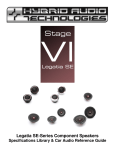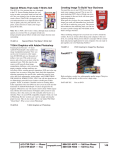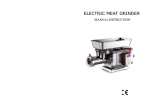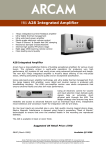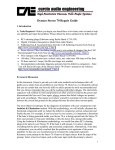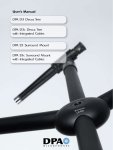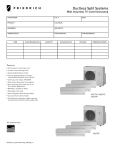Download Feb 2006 issue - Electra
Transcript
THE E-ZINE FOR FRUGAL AUDIO ENTHUSIASTS Affordable$$Audio Issue Number 2: February 2006 From The Pulpit Writer Stew Nelless lays out his responsibilities in reviewing equipment. Page 2 Infinity Kappa 200 This isn’t the typical Infinity speaker. Page 8 AudioLab 8000A Amplifier Vintage Integrated Amplifier Page 14 Energy Connoisseur C-9 Tower A satisfying minitower Page 19 ElectriPrint 300DRD Amplifier SET tube amplifier at an affordable price Page 4 DIY for the Marginally Competent Self Cleaning and other fun activities Page 10 Paradigm Titan V vs Baby Advent II Old time comparison of two entry-level bookshelf speakers Page 17 Letters to the Editor Tell us how we are doing. What you want to see, read, and review. Page 23 Nakamichi SR4A Receiver Understated quality and smooth sound Page 21 Publication Info/ Stuff All the info you could ever want to know. Page 24 In Pursuit of a Passion By Mark Marcantonio, Publisher It is the just the second day of 2006 and I am once again humbled by the effect of the Internet on our lives. Just twenty-seven hours ago I published online the first issue of Affordable$$Audio. In that time over a thousand of you downloaded the first issue. What began as a fun Christmas vacation project (honey-do list avoidance), is now a full-fledged part time operation. I have read every chatroom post and email and am overwhelmed with the positive. It seems as though Affordable$$Audio resonated beyond my own dura matter. I awoke this morning and after reading the responses the hard truth hit me in the face; how do I match the energy and enthusiasm, and improve on the quality? The first step is to develop a proper scheduling process. With the first issue, it was comparable to watching Robin Williams doing an improve routine. This issue is different, soft and hard dates were engraved. Secondly, a proper editing (for grammar) process was put into place. So, hopefully, the unfortunate errors will be first issue lore and nothing more. Secondly, I need to learn more about the publishing program Pages as upon further review, font sizes varied, and italics were not Affordable$$Audio! consistent. I am pleased with the readability of the Ariel font in pdf document format. I am still on the fence regarding the font size of 12 for the articles. Third, more graphics are incorporated, the first issue was too black and white. You will notice more advertisements for independent audio shops as time goes on. This was always in the plan as I am the child of a former small business owner. I am a firm believer in supporting local audio shops against the soulless big boxes. If the little guys disappear, so will many fine, affordable small audio manufacturers. You will also notice some ads for a few outstanding charities. Originally, I was going to put in some color boxes to take up dead space between articles. Instead, I decided to put it to better use. ! Finally, I’d like to welcome some new people, Matt Poisson, John Hoffman, and Stew Nelles to the writers coral. Matt is in charge of the youth movement. John will take us through the more affordable/estoric equipment. Stew will bring his knowledge of audio and his wonderful “Queens English” to our decidedly American prose. I hope these steps will improve your enjoyment of Affordable$$Audio. 1 A F F O R D A From The Pulpit: The Ramblings of a (not self!) Proclaimed Audio Preacher By Stew Nelless Recently my kids have been begun calling me the "preacher", not because I’m religious or spiritual in any way, but rather because I spew comments regarding lots of things and personal peeves. One of my biggest peeves is dishonesty. It’s not dishonesty in speech, or in life or in claims made in ads necessarily that peeve me (ok they peeve me; and liars and snake oil salesmen too). Rather, the dishonesties of objects or things make (or more correctly the creators of these things) concerning materials and implementation of the design and build of the object. That is, the implied promises are what I am considering here. I have developed a hierarchy for these expectations which can be broken down into parts. What is the Object? Does it function as that object? Does it function well as that object? Are apparently suitable quality materials and construction methods used? Does it feel" right"? Does it look good? An argument can be made for any object, but I will use my McCormack Microline-Drive preamplifier as an example. Questions one and two can be addressed in the same breath, that is, the object is a preamplifier, with both active and passive stages. It has three inputs and a tape monitor switch and the means to control balance and volume. I believe it functions well as a preamplifier. It has what I consider to be, little or no sonic signature (that is, it imparts little or no sound to the music played through 2! B L E $ $ A U D I O it). This is purely a subjective judgment based on my experiences with this and other pieces of audio equipment. One thing about this little preamplifier is the obvious attention to detail, robust materials and (relatively) high quality of fit and finish. I have never lifted the hood on it so I cannot comment on my own direct observations of the insides, but there have been enough reviews of McCormack equipment to indicate that they are built to a reasonably high degree. To me this little piece "feels right", the switches work and have a nice definite quality to them when they come to hand. The tape monitor switch goes "clunk" with authority when it makes contact. The source select has definite stops and "positive" positioning. The volume attenuation controls are smooth, and the control knobs themselves ooze quality with no sharp edges. To me, it just feels "right." No obvious cheapness is apparent. The one area that I could criticize is its appearance, but I won’t. Either you love the way something looks or you hate it. The visual aesthetic evokes a strong reaction, sometimes stronger than the rest of the characteristics combined. Personally, I like it. Even though it is a physically small piece, it is obviously built solidly and feels the part as well. Obviously, Affordable$$Audio is about affordable, high performing audio and so I will concentrate on how things sound primarily. But if an object "promises" something, it should deliver. And if it doesn't?, I will consider that dishonesty. If an object makes no promises (based on price, apparently poor materials, etc.), but does deliver in performance when it looks like it shouldn't? (consider the very cheesy Sonic Impact 5066 T.-amp, for example) I will consider it a bargain or a hidden treasure instead of dishonesty. The exception I may make is the typical British component syndrome; the boxes are often well built, but are usually an afterthought (at Affordable$$Audio A F F O R D A B L E $ $ A U D I O least in most of the components I have had the pleasure of being exposed to). I'll attempt to stick to it, regarding these truths in any reviews or comments I make. If I don't, feel free to reprimand me. Affordable$$Audio! 3 A F F O R D A Electra Print 300DRD by John Hoffman Electra-Print Audio 4117 Roxanne Drive Las Vegas, NV 89108 USA Phone: 702-396-4909 Fax: 702-396-4910* Specifications: 13 wpc at full output 1.4 volts for full output freq response 10hz to 40khz distortion .5% at mid power Output tube 300B Driver tube 6an4 In 1906, American physicist Lee DeForest invents the audio tube, which is a three-electrode version of John A. Fleming’s electronic valve. The audio tube was often referred to as the DeForest valve, but today is known to audio enthusiasts as the triode. The patent for the audion tube was sold to AT&T, and in 1907 DeForest founded the DeForest Radio Telephone Company. In the years that followed, Lee DeForest broadcast radio events from exotic venues such as the Eiffel tower, and the New York Metropolitan Opera House. By the 1920’s audio tubes had made the transmitting of radio signals and home radio receivers a common item in the American household. The very first tube amplifier designs were quite simple, and used a single output tube to amplify the input signal. This circuit design was the mainstay of home electronics for 4! B L E $ $ A U D I O many years. In 1947 the Williamson circuit was invented, and became the dominant circuit for commercial and home audio amplifiers. But in the 1990’s an interesting event happened. A small group of tube enthusiasts rediscovered this early amplifier circuit, and started to tout the benefits of this design. Amplifiers based on this circuit are now known as single ended triodes, or by the acronym of SET. Eventually through the efforts of fanatics such as Harvey “Gizmo” Rosenburg SET am- plifiers came out of the shadows and have taken their place in the audio landscape. Because of this audio renaissance we have seen many older tube types come back into production. For example, today we can purchase 300B, 2A3, and PX 25 output tubes from a wide variety of manufacturers. The strength of SET amplifiers comes from the simplicity of the circuit design. These amps contain fewer parts, have a shorter signal path, and are quite often hand built with point to point wiring. Since fewer parts are used, each one will have a significant input on Affordable$$Audio A F F O R D A the overall sound of the amplifier. It is generally agreed upon that the most important parts in a tube amplifier are the output and power transformers. These transformers are literally the foundation for everything that will occur in a tube amplifier. If you are lucky enough to be around a grizzled veteran of tube amplifier construction, you will have to listen to him go on and on about how important “good iron” is for an amplifier. Over the years the have been several companies that have excelled at the black art of winding transformers. If you get a group of amplifier builders together, I can guarantee you they will go on all night discussing the merits of transformers from companies such as Hammond, Magnequest, ElectraPrint,Sowter, and Tamura. Electra-Print Audio was founded by Jack Elliano, and over the years has gained a reputation of being one of the premier winders of transformers. Apparently this is not a well kept secret, because companies such as DeHavilland,Wellborne Labs, Cyrus Brennan, and Modwright use Jack’s transformers in their products. But Electra-Print produces more than transformers. They offer custom built amps that are based on Elliano’s Direct Reactance Drive circuit. For the last few months I have been listening to a pair of Jacks 300DRD amplifiers, and want to relay to you my experiences with these amps. The 300DRD amplifiers occupy a good deal of real estate in my listening room. Each amplifier has an 18-inch by 12-inch footprint, and weighs approximately 40 pounds. The up side of having such a large chassis is the amount of room the designer has to lay out parts and minimize electrical interactions. The frames are built out of solid black walnut, and the steel top plate, transformers, and capacitor are finished in gloss black. There are only 2 tubes in each amplifier. Output duties are handled by a TJ 300B Meshplate, and the pre driver tube is a Sylvania 6AN4. The overall appearance of the 300DRD is very pleasing; with a classical look to them that all tube aficionados would appreciate. I asked Jack ElliAffordable$$Audio! B L E $ $ A U D I O ano to give me a simple explanation of the benefits of the design choices he made in this amp. Jack touted the benefits of direct coupling of the output tube. Also that solid state rectification in the power supply results in the lowest amount of voltage variation during bass notes. Finally, the Ultrapath circuit eliminates any audio path through the power supply, and is responsible of the amplifiers ability to reproduce a high level of musical detail. Since I have an extremely limited knowledge of electrical design, I believe it is safe to say that I could not recognize a DRD or Ultrapath circuit if it bit me on the leg. But I can judge an amplifiers overall performance, and will take Jacks word on why his amplifiers sound the way they do. Now that the preliminaries are out of the way, it is time for the main event. The Electra Print amplifiers are fed from an Electra Print PVA pre amp. Source duties are taken care of by a Sony SCD-CE595, which has been modified by Tube Research Labs. A pair of Cain & Cain Abbey’s fills the speaker slot. Finally, Tara Labs Air 3 and Master cables connect everything together. As a general rule, single ended triodes are known to excel in the areas of midrange reproduction and the ability to put performers in a believable acoustic space. I can tell you that the Electra Print amps have the magical ability to create the illusion of a musical performance. Most importantly, these amps also have a very even tonal balance that has just a hint of extra warmth to it. The 300DRD are capable of reproducing all of the midrange detail in a recording, but do it in such an easy and relaxed manner. It can be a bit of a mind altering experience when you first encounter a good SET amp, and experience this dichotomy of detail and smoothness. A 1994 recording released by John Gorka, entitled “Out of the Valley” is an excellent disc for illustrating this point. Gorka has a distinctive baritone voice that is capable of being rich and resonant, and at other times has a surprising ability to convey the emotional content of a ballad. A good amplifier will highlight his vocal abilities, while 5 A F F O R D A an average one will lose the little details and smooth the sound over. Well the Electra Prints are good amplifiers, matter of fact they are one of the most capable amplifiers I have heard for reproducing a performers voice. The title track “Out of the Valley” is an emotional ballad that portrays the struggle of young people living in a small town, and attempting to leave it for a better life. It is a song that contains poignant lyrics, expressive guitar playing, and a vocal performance that lets all the emotion of the writer flow through. The 300 DRD amps let you experience this in a manner that few traditional amplifiers are capable of. This is the primary strength of a single ended triode amplifier, its unique ability to portray all of the music in a manner that lets the listener experience a performance and not just a song. Another cut; “Flying Red Horse” features Mary Chapin Carpenter as a guest vocalist. Her dark and smokey vocal style is an excellent addition to Johns, and their individual styles highlight and compliment each other’s strengths. The 300DRD amp does a stunning job of letting each vocalist’s performance stand on its own merit. The amps have the rare ability to present the individuality of both vocalists, and to contrast their different vocal gifts. At the same time these amps can show how smoothly their voices blend together and harmonize, creating a unique auditory experience. This level of vocal realism is very difficult to achieve, and is what makes these amps worth owning. Single ended triodes have the ability to create the illusion of acoustic space in a manner that few solid state or conventional tube amplifiers are capable of. In more than one instance I have heard various SET amps coupled with high quality horn speaker systems that had all the speed and trans6! B L E $ $ A U D I O parency of electrostatic, or ribbon speakers. And they had dynamic range, and extended bass response that dipole speaker could only dream of. The Electra-Print amps have this ability to create a believable soundstage, and to properly place the performers within it. These amplifiers are present a wide stable soundstage, and have very good front to back depth. On Ellis Paul’s release “Say Something” the track “Thin Man” highlights the Electra-Print amps capabilities in regards to creating a believable soundstage. This is a minimalist recording that consists only of Ellis Paul, his acoustic guitar, and you the listener. The Electra-Print amps not only create the illusion of Ellis Paul in your listening room, but they also allow you to hear the acoustics of the recording venue. It becomes very easy for the listener to close his eyes, and imagine being seated in a small, dark club, just a few feet off of the stage. When paired with the right speakers, the 300DRD amps can be holographic in its ability to recreate performers and their instruments. Affordable$$Audio A F F O R D A The high frequency performance of the 300DRD amps portrays a classic tube heritage. The treble reproduction is smooth and refined without any hint of glare or harshness. Although the amplifiers sound relaxed in the upper registers, they do not artificially roll off the high end frequency response. Sony has released several songs on SACD by The Bangles, including “The Hazy Shade of Winter” The opening tambourine sequence is so clearly reproduced that I felt that if I tried hard enough, I could count the exact number of metal cymbals in the tambourine. The accompanying guitar work was so quick and precise, with the decay of individual notes occurring so quickly that they appeared to just vanish. But most importantly, the Electra-Prints did not alter or cover up the tonal balance of the recording. It still remains obvious that this is a commercial recording, and it has a distinctive sound that is often associated with pop music. Bass performance and dynamic range are the two main areas that people find fault with single ended triode amps. This is quite understandable since the majority of SET amps bring less than 15 watts to the table. The 300DRD has competent, but not exceptional performance in the lower registers. These amps have quick and tuneful bass, that never gives the impression of being bloated or euphonic. But the champion of deep bass response in the 13 wpc weight class is the Art Audio Diavolo. The Diavolo has an iron fisted control over a speaker’s woofer, and is capable of creating bass that drive other SET amps green with envy. Quite simply, the Electra Print cannot match the Diavolo in this category. But that’s understandable, because I have yet to hear another amp based on 300B tubes that could. I found that acoustical bass instruments, such as cellos, tubas, or kettledrums were reproduced with plenty of weight and extension. On Aaron Copeland’s “Fanfare for the Common Man” the opening percussion lines had substantial weight and authority. But when you changed genres to modern electronic music such as techno or trance, the 300 DRD tended to run out of steam before the music Affordable$$Audio! B L E $ $ A U D I O could reach dance club levels. Although, with careful selection of speakers, any perceived bass response issues could be minimized. At the end of the day it is time to tally up the scorecard for the Electra-Prints and determine if they are worth your hard earned money. With a retail of $2500 these amps are not inexpensive by any stretch of the imagination. Although this pair of amps were acquired from the used market for approximately $1100. Objectively speaking, these amps have an excellent tonal balance, the ability to extract large amounts of inner detail, and throw a wide and deep soundstage. But there is more to the single ended triode experience. The 300DRD amps allow the emotional experience of the music to flow through your speakers, and take up residence in the listening room. When people encounter a properly matched SET system for the first time, quite often they are literally blown away by intense connection they get to the music. And that is what these amps are capable of. The Electra-Print 300DRD amps are inherently musical, and can be the cornerstone to a very satisfying audio system. 7 A F F O R D A Infinity Kappa 200 Loudspeakers By Mark Marcantonio 2 way Bookshelf Loudspeaker 1-6.5 inch CMMD Driver 1- 1inch CMMD Tweeter Rear Ported Gold Plated Posts, Bi-wiring Necessary 50-27Khz Frequency Response 14-5/8" high by 8-7/8" wide by 14-1/2" deep New $599 each, Used $199-250 each Infinity speakers have a love/hate relationship with audio fans. The IRS and Intermezzo series have had a tremendous amount of critical success over the years. The original Kappa’s have a loyal and dedicated fan base. This is due to the higher quality of engineering and an honest desire to improve upon previous performance standards. A few years back Infinity decided to reintroduce the Kappa line with a whole new lineage. The speakers would be born and bred of Danish design with simple, rounded lines meshed with a pewter-colored plastic front panel. The look is different, yet clean and pleasant to most eyes. The form actually makes the speakers look bigger than they actually are. This is from the rounded, almost bullet-like shape of the box. The build quality is exceptional and the real cherry veneer on the models I reviewed were impeccable. Infinity says the following about their drivers: “Working collaboration with metallurgy specialists, the resourceful Infinity transducers engineers identified a special combination of materials that exhibit a remarkably useful set of mechanical properties. Infinity’s new Ceramic Metal Matrix Diaphragms are much stiffer than standard metal diaphragms, moving the natural resonances upwards in frequency. At the same time, CMMD cones have more damping than metal cones, making this an excellent 8! B L E $ $ A U D I O cone material for all transducers: woofers, midranges and tweeters.” What all this means is that an aluminum center has a specialized ceramic/metal covering creating a driver the “dramatically” reduces distortion. The pair I reviewed had only a few hours of activity on them, so a thorough break-in period was needed. A combination of music and white noise was played thru them constantly for the better part of two weeks. The rather stiff cones finally did loosen up somewhat, but not to level I’ve experienced with other speakers. Even at moderate to higher volumes the driver cone barely moved. This was my first indication that either the Kappa 200’s craved power beyond the listed 100 wpc maximum, or the CMMD cone design was a very stiff composite. True to Infinity’s word, the CMMD cones do reduce distortion. The music coming forth was clean. What distortion I did hear came from the sources I was using, not the speakers themselves. True to it’s old-world birth the Kappa 200’s do not sound like a typical Infinity, or American speaker for that matter. The sound is very European, laid back with emphasis on neutrality. With certain music this can be quite pleasant, such as light symphonies and the infamous office music. The Kappa 200’s were setup in my living room (approximately 18’ x 12’). The speakers were placed on 24 inch metal stands approximately twenty four inches from both the side and back walls after much shuffling. Connection was the poor man’s bi-wiring. It should be noted that the Kappa’s binding posts are arAffordable$$Audio A F F O R D A ranged in a four across pattern instead the standard two-over-two. Both 14 gauge and heavy original Monster cable were used as interconnects. No appreciable difference was heard, unlike the Linn Keilidhs reviewing in the January 2006 issue. To be fair, I tried the Kappa 200’s with both my Harman Kardon AVR 75 receiver and the Adcom GFA 535. My immediate impression was clouded by a rainstorm that masked the musicality of the speakers. I tried again the next day, the sound only improved slightly. It seemed as though a heavy curtain was placed between the speakers and my chair. The HK just didn’t have the power to create any life whatsoever. Even with its high current capability, the performance just didn’t exist. Nothing more need be written. The Adcom, true to its design, did push the Kappa’s but not into being forward, but a soundstage was created. It went out just a few feet then up from the speaker placement and backwards rather than toward the listener. This “come to me” sound may be easy to listen to, but left me emotionally unsatisfied. However, opposite of Infinity’s heritage, rock music lacked energy. The Who’s masterpiece “Quadrophenia” lacks the emotion that makes the recording so powerful. I never felt drawn into the music. One could try to say that my “American ear” wasn’t prepared for the nuances of European sound, but that isn’t the case. I spent fifteen wonderful years savoring the sound of my trusted Celestion SL6si’s. B L E $ $ A U D I O smooth quality, with a slight warmness. Piano music came across with a natural decay of key strikes. What was fascinating was how the foot petal was placed low and to the left of center, yet the vocals placed themselves actually back from the speakers a good foot and a half. This reverse soundstage beckoned me to lean forward in my chair and walk between the speakers. The result was both confusing and pleasant in that there were no “dead zones”. If this were a workout room with a number of machines the Kappa’s might have worked quite well. The Kappa 200’s performance for me may explain why this model is such a rare find in the US and Canada. It’s characteristics I bet left many potential customers confused. Longtime Infinity Kappa fans must have felt puzzled, if not abandoned by the drastic change in sound. It is so very, very different. If you are interested in this series of speakers (the Kappa’s also come in a 400 and 600 models) make sure to audition them in your own home. I didn’t before buying. Now they inhabit the list of equipment I used to own. This is not to say the music produced by the Kappa 200’s was bad. Acoustic guitars had a Affordable$$Audio! 9 A F F O R D A DIY – By and for the Marginally Competent. By Bob Lombard This article, and any that may follow it, is not intended to educate experienced audio Do-ItYourselfers. If you are one of those, feel free to read on and send critical letters to the editor. (Just be aware that for some editors, any feedback is good feedback.) The intent is to help make the use of vintage (i.e. affordable) equipment more practical for the ‘common man’. That “new-to-you-but-vintage” integrated amplifier – Getting it ready It’s setting there on your workbench, looking good. You don’t know anything about its history for sure, and it may not have been powered up for a long time. So… before you power it up, there are some things you ought to do: cleaning, preconditioning, adjusting things. I know, the temptation is great to fire it up – but if you do, there is a small but real possibility of seeing smoke. B L E $ $ A U D I O ommend anything else, because some of them leave residue, and I don’t know which ones. ! A (probably Philips) screwdriver for removing the amp’s cover. Some amps make you remove the faceplate to get at the switches. ! A small common screwdriver for adjusting pots. The Poor Man’s Variac (PMV) This photo is not of my PMV, which is too ugly for public viewing. This PMV belongs to the gentleman known at Audio Karma.org as Morden2004, who graciously granted permission for the use of the photo here. Equipment required: ! The service manual for this model. Without this, you won’t know which pots do what, or what their settings should be. ! A variac – either a real one or a PMV (Poor Man’s Variac, using light bulbs). You use this to wake up the amp gently after its (presumably) long sleep. ! A VOM (aka DMM). Used when checking/setting DC-offset and idle (bias) current. ! A small paintbrush, of the type used to apply varnish. You use this as a duster. ! A can of compressed air, the sort used to clean computer keyboards. ! Electrical contact cleaner – Deoxit or Permatex (item #24379 in case there are others) recommended. I can’t rec10! Photo #1 - Morden2004’s PMV How to make your own: Materials: ! A ceramic receptacle for standard base incandescent light bulbs and a junction box to mount it on. ! A power strip, preferably with switch. Surge suppressor not required. ! A length of 2x4 to use as a chassis. Needs to be long enough to mount both junction box and power strip. Affordable$$Audio A F F O R D A ! Light bulbs: 25, 40, 60, 75 and 100 watt incandescent. B L E $ $ A U D I O screws in the back. When it’s off, you can see into the Area of Operations. 1. Mount the junction box on one end of the 2x4. Open holes at both ends. 2.! Cut the power cord in two about 4” from the power strip. Remove about 2” of the outer covering from each end of the cord, exposing the (insulated) conductors. Strip about ½” of insulation from each conductor. 3. Bring the cord ends into the junction box. Reconnect the ground (green) and white conductors and tape the connections. 4. Connect the black wires to the terminals of the receptacle and mount the receptacle to the junction box. The light bulbs provide the ‘settings’ for your variac. We need an amp to use as an example; here’s my Sansui A-7, in its unopened state: Photo #2 - Sansui integrated amp, model A-7 1st operation – cleaning The majority of integrated amps (and tuners) have top covers that are also side covers; they are fastened with two screws on each side of the amp. The Sansui A-7 is different, just two Affordable$$Audio! Photo #3 - The Sansui A-7 – cover off These innards are clean. Your amp may be clean too, depending on where it was used and stored. If things are dusty (or worse), start with the can of compressed air. You may wish to remove the amp’s bottom cover now, to give the dust an open ‘way to the egress’ (sorry, I blame this on P.T. Barnum). If there’s significant dirt left, see what the small paint brush can loosen up, then use the compressed air again. If there is still a layer of crud, maybe yellowish from tobacco smoke, you can resort to isopropyl alcohol and cotton swabs. Don’t use any more alcohol than necessary. One reason for this seemingly compulsive fussiness is that as you are cleaning, you will (hopefully not) see any evidence that electrolytic caps have been leaking. If you find any leakers you need to replace them before power-up. Now you can clean switches, using the electrical contact cleaner. In this amp the switches are accessible after the top cover is removed; in some amps you have to take the faceplate off too. Give each switch, both rotary and pushbutton, a good dose of cleaner, operating each one several times as you proceed. The cleaner will evaporate quickly. If your amp has DC-offset pots, it makes sense to clean them now, in the same fashion; carefully note the pot’s current position, so you can return to it. Just spraying the pot with cleaner won’t accomplish much; you have to turn it through its travel a few times. Some 11 A F F O R D A B L folks advocate cleaning the bias pots during this operation. If that’s your plan, make very sure to return the pot positions to where they were. Folks who are not the above “some folks” prefer to leave the pots as they are, in the expectation (hope) that the settings will be good when checked, or that they will function correctly if they have to be adjusted. This – marginally competent, remember – writer takes the second choice, modified. I don’t mess with those pots now, but if I find that they need adjustment when I get to that step, I go back a step and clean them before moving them with power on. A “jumpy” bias pot can make for fried components downstream from it. This amp doesn’t have DC-offset pots; you can see the bias pots in photo #3 – about in the middle of the picture. 2nd operation – the slow wake-up For this step, I recommend that you set the top cover back on the amp. No need to install the screws; the thing is that there is a small chance that one of those electrolytic caps will ‘pop’. Connect your variac to power, with its power switch off. Connect the amp to the variac, power switch off, volume knob at 0 (for luck). If you are using a PMV, screw in the 25 watt bulb; if a real variac, set it at 45 volts. Turn on the amp’s power switch, then the variac – watch for smoke, ready to turn off the variac. The amp’s speaker protection, if it has such, will likely stay active, but the caps will charge. The bulb in the PMV will dim as the caps charge. If no smoke is rising, leave the setup going for about 20 minutes. If you are using a PMV and nothing bad has happened, turn its power off, replace the 25 watt bulb with the 40 watt bulb, and turn on power again. With a real variac, turn the voltage up to 60. Repeat the 20 minute wait. Repeat the procedure, 60 watts, 75 watts, 100 watts (or 75 volts, 90 volts, 105 volts). If the amp passes, the procedure is finished. The amp should handle full power OK. Turn the amp off. 12! E $ $ A U D I O Somewhere during the process the protection circuit should deactivate a few seconds after power-up. If it hasn’t done that by the last step, cross your fingers and plug the amp into a regular receptacle (no variac), and turn the amp on. If the protection circuit stays in indefinitely, there is a problem that is probably beyond the expertise of the marginally competent. You’ll need to go to someone who’s better than marginal. 3rd operation – checking/setting DC-offset This amp has no DC-offset pots, and yours may not, but you still ought to check the offset. It should be within a few millivolts of zero. Sensitive ears will detect sonic degradation at 15 or 20 mV offset (my ears aren’t sensitive, I’m going by expert opinion here). Anyway, even if your ears aren’t sensitive you could consider corrective action desirable if the offset is more than 20 mV, as a matter of pride. The deteriorated component is probably a regulating resistor or cap; figuring out which one is the problem, and I can’t help you there. If your amp has DC-offset pots, locate them on the circuit board by referring to the service manual. With the volume pot set at zero, turn on the amp and let it warm up for at least 20 minutes. Then turn on your VOM, selector set at the 300 mV DC position and the red probe lead in the Volts-Ohms jack. Connect the probes to the speaker terminals of the left channel, positive to positive. You should see a reading on the meter, either negative or positive (no sign). The service manual will probably tell you to set the offset to zero mV +/- 1 mV. If the reading is negative, turn the left channel pot clockwise – in small increments – to bring the reading to zero. You may find zero hard to get to, but don’t give up until you are at least within 2 mV. If the pot acts squirrelly, i.e. the meter reading jumps around when you move the pot setting, you may need to power down the amp and clean the pots again (clean both of them while you’re at it). Affordable$$Audio A F F O R D A B L E $ $ A U D I O I would tell you to check/set the right channel when you’re done with the left one, but you knew that already. 4th operation – checking setting bias current Here’s what the Sansui service manual has to offer: Some amps bring the test points to the top of the circuit board; clip leads work best there too. Some amps don’t provide test points, but have you remove a fuse and read milliamps across the fuse-holder; small insulated alligator clips are handier for connecting to a fuseholder. From the manual, a photocopy and a table Here’s the real thing: Photo #4 – Sansui bias pots The pots are pretty easy to find, the aluminum-looking things with screwdriver slots about in the middle of Photo #4; the test points aren’t so easy. The white rectangles below the pots are the resistors referred to; points "A" and "B" are the outer legs on the left resistor, points "C" and "D" are the outer legs of the right resistor.The probes on your VOM leads won’t do for this, and alligator clips aren’t much better; you need clip leads like this one: Photo #5 – IC clip leads Affordable$$Audio! With the amp turned off and volume control set to zero, attach the leads to the test points for the left channel. Don’t turn on the VOM yet, or connect the leads to it. Make sure that the leads are where they should be, and nothing is getting shorted. Turn on the amp and let it warm up for at least 10 minutes. Then turn on the VOM, set it up to Volts-Ohms and 300 mV (DC amps and 300 mA if your are checking across a fuse-holder) and connect the leads to it. Let the meter reading settle. It can be 10% or so higher than what the manual calls for (they tend to be conservative), but shouldn’t be lower. If the reading is unacceptable, and you cleaned these pots while doing the other cleaning, Use a small insulated screwdriver (both handle and shaft insulated) to move the adjustment a small amount. If you see the meter reading go to zero and then return to a different number as you turn, the pot is ‘skipping’ and still dirty or corroded. You may not be able to get to the setting you want, because it’s in a ‘skip’ area. You should power down and try cleaning it again. Sometimes, especially with older pots, cleaning isn’t enough and the pots will have to be replaced. If things go well, turn power off and move the leads to the test points for the right channel. When you have that one set, power down, remove the leads, and replace the amp cover. You’re done. 13 A F F O R D A B My Old Friend: The Audiolab 8000A (first series ) Integrated Amplifier By Stew Nelless The Audiolab 8000A integrated amplifier is an old friend. I have listened to this amplifier for the better part of fifteen years. To me, it feels like coming home. It is a full functioning, integrated amplifier (including a MC and MM phono stage). Well-built chassis--- terrible sheet metal. The front panel is well built and simplicity itself. All controls are well laid out, have a reasonable feel to them and are easy to discern. Finished in a dark grey, it is handsome in the utilitarian sense of the word. No, Tag McLaren made the electronics high style, but the basic Audiolab is not ugly. Typically British with cheesy, sheet metal. Knock on the top or sides and it rattles like a 30-year-old Datsun 510 (I owned one of these great cars too. I got rid of it because, at that time, I was a young idiot—I simply didn’t appreciate what I had). No engineering degree or the ability to contort one’s body is required to operate it. Connections are RCA connectors for all inputs including 2 phono inputs (one for MC and another for MM cartridges). The amp has a push-in switch to set which phono stage is being used. Two sets of small binding post suitable for spades or push in style banana connectors take care of the speaker connection facilities . They also accept bare wire. Also present is an IEC AC input socket, allowing you to change to the AC cable of your choice. The stock cable is of good quality. This amp was owned by me and sold last year to finance my McCormack purchase. I had modified it per instructions from Artech (formerly the North American distributor) to separate the power and pre-amp sections and used a short pair of Audioquest Ruby interconnects to join the pre-amp out to power amp section, or used a passive pre-amp with Alps 14! L E $ $ A U D I O “blue” attenuator. It is in this incarnation that the old amp remains. Rated at 50 or 60 watts per channel (depends on the magazine or year). It is capable of good drive on most woofers and therefore has the impression of muscularity. Sometimes criticised for being polite, it (this early example) can be particularly revealing. Intolerable of poor sources (or any with a rising top end), it sings with the right stuff. Listening tests were conducted in “the lair”, a 19' X 12' (with an 8'X8' bump out on the back wall) basement room with concrete floors and 1970's old school “panelling”. The floor is carpeted with thin pile orange and brown carpet, and has a wood/mirror ceiling. The end of the room opens up via 3 brick arches into another 10' X 25' opening. Loudspeakers that were used: JE Labs baffles with Oxford J12s fullrangers (and Seas tweeters) and the cheap and cheerful Athena AS-B1 bookshelfs. Both were connected to the amp via Cat 5 cable. Sources used were the Sony CDP 990, the modded Sony Playstation, and the Oracle Alex/SME 309/ Grado Sig 8.. Music picked for use were my “standards”... Mary Black's “the collection” (Grapevine GRACD 010), John Lee Hooker's “The Best of Friends”(pointblank 7243 8 48424 26), Naim’s Hi-Fi Collection 2(HFC259-10-04, a free cd w/Hi-FI Choice , Oct o4), James Taylor Greatest Hits (Warner Brothers, lp version BS2979), Mozart Requiem KV 626, William Christie and Les Arts Florissants (Erato630-10697-2 ) and John Williams and the Boston Pops “Out of this World” (Philips 411 185-2 –the cd version number. I misplaced my record before quoting it here :-( ). Affordable$$Audio A F F O R D A I first tried the Audiolab with the Sony CDP 990 and the open baffles. Regardless of which music I put on, there was always an aggressive quality to the sound to the sound. Interconnects were the Audioquest Rubys as per usual, and are not a “zippy” cable by any stretch. The music had everything one would expect . . . appropriate sound stage height and width, but an irritating top end that stayed with all selections played. I then tried it with a Marantz CD5000 that was here at the house for a little while. Much better! Substituting out the Marantz for the Playstation, better yet again. Don’t be fooled, Sony had one hell of a cd player in the PSX (original). A few minor mods improves it immensely. It was in this incarnation of the system that I completed my listening, and where my caveats come from. Please put a source that is extended but not too bright in front of this amplifier. With that caveat taken into account, the Audiolab will drive most speakers I have ever tried with it well. With the Athenas, the sound was bigger than one would imagine, but veiled. There was a slight tendency to a “cupped” or “canned” sound. This is simply a function of box type loudspeakers (I have never had any great boxed loudspeakers, although my little Castles are pretty well made boxes). Switching to something like DCM TF250 loudspeakers a veiled but “boxless” sounding speaker, removes the “canned” sound. I have had the same experience every time that I have listened to a boxed loudspeaker and then returned to the OBs or other boxless types, there is simply no comparison. Ask anyone who has experienced Magneplanar, Martin Logan, Quad ESLs or very good small monitors such as Pro-Ac Tablettes, or the high end Celestions of yore: SL6s, SL7s, SL700s, or the recently heard (by me) Basszilla’s. It’s SO hard to go back. But now the great news. The AUDIOLAB LOVES TO PLAY MUSIC. It is perhaps the closest thing that I have found to an audio apAffordable$$Audio! B L E $ $ A U D I O pliance. I plugged it in the first day I owned it and didn’t change it for over 12 years. With soft, slightly “dark” sounding speakers, the amp “drives;” and the sound perks up. It does well with revealing loudspeakers. It portrays the Music in a toe-tappin, let’s dance, sort of way. Not in the Flat Earth style, but it moves along just the same. I can say that in my time as an owner of this amp, I had never forced the amp into clipping. You’ll want to leave the room well before this happens. I never felt the desire to change the amp unless direct comparisons were made against much more costly amplifiers. My critical test for top end performance is Mary Black’s most excellent “Song for Ireland”. During one of the crescendoes, her voice can screech and become very unpleasant to listen to. I have only hear it reproduced in a very controlled and smooth manner on perhaps one or two systems that utilized separate transport/ Illuminati D60 /DACs systems. I am not saying others can't do it, just that I have no first hand experience with other players that don't. She simply belted out her voice in a sweet, beautifully portrayed manner. Ditto for her duet with Eleanor McEvoy (“Only a Woman’s Heart”) on the same disc. Voices were distinct, but harmonious. There is a reason why these two performed this song together. Bass was powerful and authoritive. On John Lee Hooker’s duet with Bonnie Rait (“I’m in the Mood for Love”), the electric bass seemed real. Not overpowering, but bronze strings plucked with human fingers. Listening to” Tupelo”, I heard John Lee’s breathing –the result of close miking his voice, and got the sense of feeling what and why he was singing and the richness that his voice provided. The acoustic guitar seemed “right”. A sense of space was evident on the “Steamroller” track on James Taylor’s album. Clapping sounded like clapping, the crowd’s “hecklers” (actually “encouragers”) were distinct and easy to hear. There was no hi-fi illusion. Just the great sound of JT rockin’ out to a great old song. As far as phono performance and listening, The John Williams album (remember those boys 15 A F F O R D A B L E $ $ A U D I O and girls?) was big, spacious and involving... and quiet. So, how can I summarize the Audiolab? Critical of source components. Nicely constructed (in the overused, British, cheesy sort of way). Not ugly, but not great industrial design. Useable connectors, but not great. Good facilities, Great sound. Now as a used component, be aware that there are areas of concern. The RCA inputs are of the PC board mounted type. and are made of some sort of plastic or thermal set. Over time they do fatigue and crack. The ones on this amp need to be changed or a wholesale upgrade to proper panel mount types is needed. The speaker “binding posts” are of perhaps the minimal quality permitted. If ya have a few dollars and are handy (or know someone who is) spend it on some respectable quality ones, available from several online resellers, wholesalers, etc. Neutriks seem good and inexpensive to me. They might be worth considering without going to all-out expensive (but very good Cardas or WBT ) types. So far, no caps have been replaced on this unit, but any old component can benefit from a thorough inspection by a good tech, whether a backyard type (many I know are superior to some of their “professional” counterparts) or a shop employed one. Allow some dollars for that. Perhaps a $100 investment in time and a few high value parts as upgrades and say $200-300 for the amp. I doubt any will consider it a poor buy. Newer versions come up on ebay etc. One is being offered at $355 bid as of this writing. I think it may go to $500. If bidding on UK (or other world market) pieces know that to get it here and run it in North America (a 120V to 220V power transformer is needed), may cost much more than to wait until one comes up or can be located in North America. I think it is well worth the wait. 16! The Battle of the Bookshelf’s: The Mighty Affordable$$Audio A F F O R D A Paradigm Titan Vs The Baby Advent II By Matt Poisson Speakers: Paradigm Titan: • 6.5” woofer • ¾” Dome tweeter • Ported bass reflex design Advent Baby II • 6.5” Acoustic suspension driver • 2” Ferro fluid dome tweeter A rundown of the test system: For this review I enlisted my newly acquired amplifier, the Layout of listening test: Left Speaker Right Speaker CDP Amplifier Listening Spot 11ft 2ft 2ft Music Choice: Track1: Eric Clapton Unplugged – Old Love Track2: USACi test disc: Sweet Georgia brown Track3: USACi test disc: Fever Track4: Keb Mo’: Soon as I get paid Track5: Lenny Kravitz: Thinking of you Review: With everything set up, and my first track ready to play, I sat back on the couch and closed my eyes to block out anything that may distract me from using my hearing sense to its full capability. With the press of the play button on my DVD player I was ready to listen to what the Advents could do. Right off the bat, the Advents were warm and colorful, with loads of character. These are the types of speakers that you can listen too all day without fatigue. They were well balanced in the upper and lower registers, and the tweeter did a good job of pronouncing the strings of the guitar, and rasp of the trumpets Affordable$$Audio! B L E $ $ A U D I O in a few of the tracks. The sealed cabinet allowed the small 6.5” driver to travel fairly low in the frequency range, but not enough to provide a chest pounding impact like a larger driver would typically do. I also found that on some tracks the mid bass sounded a bit muffled as if I were listening to the speakers with a cover over top of them. Removing the grills on both didn’t help remedy the situation that much. Further listening of the Advents provided some really nice detail in the program material. Sitting back with my eyes closed, these speakers really brought to life the wide variety of instruments used, from the plucking of the acoustic guitars to the trumpets in the jazz tracks, it all seemed very realistic. One of the downsides to the Advents was the lack of soundstage. While I found both the Advent and Paradigm to be lacking in this department, I more so found the Advent at times to be very precise where the vocals were coming from, and instead of being an open and airy soundstage, I felt you could too easily pinpoint exactly where the voice was coming from, which was somewhat of a disappointment. Once the first round of listening was complete, I swapped out the Advents for the Paradigms, and placed them in the exact same location and wired them up. The first thing I noticed is these speakers were a fairly bit more sensitive, as I had the gain set a bit lower for the same desired output with the Advents. After listening to the first few tracks, I quickly noticed that the soundstage on these little monsters was a lot wider and more 17 A F F O R D A transparent than the Advents. While I sat back on my couch with my eyes closed, I could hear the different instruments being played in different spots, and the voice was more central, instead of coming directly from the speakers like it was with the advents. The highs were very smooth, and the blend from the lower and higher frequencies was very well done. Detail in the music was very pronounced and I could hear little things in the music I couldn’t pick out as well with the Advents. One downfall with the Paradigms that I heard was the bass output. In my opinion I didn’t find it as musical as the Advents. The ported cabinet could cause this, but I found that not as much detail was prevalent in the lower registers as it was with the Advents, although both speakers had solid bottom end for their respectable sizes. B L E $ $ A U D I O pair of either, I suggest you do so, and will not be disappointed in the performance these little contenders pack. Related Equipment: Samson Servo 260 • Providing 130WPC@4ohms, and 85WPC@8Ohms • 20 Hz To 50 kHz frequency range • Low THD of 0.03% CDP: Apex Progressive Scan DVD Player Cables: • 15 awg OFC speaker wires • Custom 3ft interconnects with gold plated connectors No preamp was used in this test. The CDP was fed directly into the Samson Servo and the adjustable gain was used on the amp to eliminate any possibilities of coloring the sound, or adding any more qualities that might not be desirable for the test. After the listening test I was left with a good feeling that these speakers gave me. Being enveloped in the sound and for it to sound really lifelike is a nice quality to have in such a small speaker. A rundown of both speakers revealed: Baby Advent II Pros: Smooth bass response with nice low extension. Warm mids and highs. Cons: Lacking in wide soundstage. Paradigm Titan: Pros: Low bass extension with powerful impact for its size. Warm mids, detail highs. Very open soundstage with lifelike realism. Cons: Bass can sound a little boomy at times. Both are real winners in their own way. The cons weren’t great enough to make me put these speakers away, as I found a style of music each one was better at reproducing that the other. If you get a chance to try out a 18! www.echohifi.com Affordable$$Audio A F F O R D A Review of: Energy Connoisseur C-9 By Steveinaz (Polk Club member) Editors note: This review originally appeared in Polk Audio discussion board before the review standards were setup for this e-zine. The author has given permission for it to be published here. Specifications: Freq Resp: 31-23kHz, +/-3dB; -10dB @ 26Hz Power handling: 250 watts per channel Efficiency: 91dB @ 1watt/1mtr Woofers: 2 x 6.5” Homopolymer w/rubber butyl surround Mid/Woofer: 1 x 6.5” Homopolymer w/ rubber butyl surround Tweeter: 1 x 1” chambered aluminum dome Binding post: 1 set of 5-way Dimensions: 45” x 7.75” x 18” (HxWxD) Weight: 62lbs each Retail: $1300.00/pr Listening: As with most speakers, give these a good 30 hrs of run-in before listening critically. Initially they will come off as somewhat dry and dark, give it time and you’ll be rewarded with some seriously smooth music. First of all, I’m still amazed at the bass these narrow column type speakers reproduce; it’s almost like an optical illusion. You see this tall skinny thing reproducing incredible bass, and you know there is a sub hidden---somewhere. The C-9 has 2 bass ports; one in the front near the bottom, and a second port on the back, about 3/4 up. I would imagine the combination of the tuned ports and the 18” depth of the cabinets explains the room energizing bass. And these Affordable$$Audio! B L E $ $ A U D I O pups dish-out some serious, tight bass. They plunge 6Hz lower than my previous dual-8” towers. I noticed in the Soundstage review of the C-9, they had to push the speaker much farther than they typically do to get any reading of distortion in the lower bass—impressive, and exactly what I experienced; deep, clean well articulated bass. I have to take a second to mention the binding post. These are very impressive; they look like WBT binders with a large heavy grade clear plastic knob surrounding the gold plated screw-down. It makes tightening a tool-less proposition, as you can really get some torque on the posts. Very Cool. BTW, the C-9 is not bi-wireable. Also, quick mention of the grilles; they are magnetized—no posts to break off or wear out, easy on, easy off. The magnets are also damped to eliminate vibration. Again, very cool. I did all of my listening with the grilles in place. The tweeter is nothing short of magnificent. It does everything right. Not too bright, not too laid back, crystalline and airy without being prominent or etched. The crossover must be very well engineered, as I can’t detect any transition from the mids. There is a very smooth, tonal neutrality about these speakers that almost sounds like a single full-range cone. I kept thinking to myself “these remind me of my AR9Lsi’s in a BIG way.” The easygoing, extremely listenable sound has you running through your CD library as if someone is going to take your system away tomorrow. What’s really sort of a paradox is that although they sound a touch laid-back, they are at the same time quick and articulate, very nice blend. Comparing these to the V.2 Paradigm Reference Studio 60 ($1600/pr) and 100 ($2300/ pr), the Studio 60 is simply out-classed. It just isn’t capable of the deep, cleanly rendered bass lines, and the C-9 gives nothing away in the midrange/treble. The Studio100 is a more apples to apples comparison. Though the 19 A F F O R D A Studio 100 has a touch deeper bass, the C-9’s smoother upper-midrange and linearity in the extreme treble gets the nod. I will say the Studio 100’s mid and lower midrange is impeccable, and the overall tonal balance, top-tobottom, leans ever so slightly in the Paradigm’s corner, for $1000 more, it better. Comparing to my Athena AS-F2’s ($600/pr), the C-9 is less bright and in-your-face. Treble is sweet, without being over-bearing. The midrange sound-staging is better, probably due to the smaller 6.5” driver, and a touch more neutrality. The AS-F2 has very good bass, but just doesn’t dig quite as deep, with as much ease as the C-9. The big difference was clear when pushing the speakers hard. The Athena’s would tend to unravel a bit at high volume, becoming a little unsorted. The C-9 just kept sounding better and better, the harder it was pushed---almost like it was saying to me “that all you got, punk?” B L E $ $ A U D I O the performance and makes you want to listen to every track, just to see how it’s going to interpret the next note. They "scared" me a little at first. Initially they sounded pretty dark, but after listening for awhile I realized that it wasn't that the Energy's were dark, it was that the Athena's were too bright. The tonal balance is superb, and they love to be pushed hard. What really amazes me is the ability to energize the room with bass, even at whisper quiet levels. I couldn't be happier. This is not a good "showroom speaker." It needs to be listened to for a longer period of time to be really appreciated. Because of its neutrality, it would probably lose out in A/B comparisons because people tend to pick what stands out the most. The C-9 really needs some power to reach their potential. I would recommend 200 watts or more. My amp pushes about 215 per channel. They like to be cranked and because of their laid-back nature, most will push them a bit harder than a more forward biased speaker. You've got to give them time to really appreciate the tonal balance and accuracy they bring to the table. Like I said earlier, the C-9 is not a good "demo room" speaker, their magic is sneaky and subtle. Much like the aforementioned AR9Lsi and the NHT 2.9. Again and again while listening to the C-9’s I kept thinking of how much their tonal character reminded me of my early 1980’s AR9Lsi speakers. I even mentioned it to my wife, twice. The entire time I was writing notes for this review, I was looking for the right word… .then it finally hit me…“alluring.” The Energy Connoisseur C-9 is alluring. It drags you into 20! Associated Equipment: - C.E.C. CD-3300 CD transport AES/EBU digtal output - Benchmark DAC1 DAC - Musical Fidelity A3CR Preamp - Parasound HCA-1500A Power amp - Kimber PBJ Interconnects - Signal Cable AES/EBU digital cable - Kimber 8TC speaker cable Affordable$$Audio A F F O R D A Nakamichi Stasis SR-4A Receiver. By Mark Marcantonio Made from 1987-1989, regulated power supply, extensive video switching. 60 wpc/cont, retail $1,000. Used Features Nak's 'Inherently Stable / Uniform Impedance Amplifier'.. Remote capable, not included. Pre out / Main in jacks for easy system expansion (use as a pre/tuna). Normally, when an audio enthusiast sees or hears the word “Nakamichi”, the first image that comes to mind is the Dragon, the king of all cassette decks. A piece of equipment so universally admired and desired that it retired with the crown of “Ultimate Cassette Deck”. Luckily, for us Nakamichi made other products as well. One of their finer receivers was the SR-4A. A seemingly average-looking piece of audio, with a bundle of fine touches under its hood that separated itself from much of the competition. Affordable$$Audio! B L E $ $ A U D I O True to the styling of the time, the Nakamichi SR-4A exterior came in a satin black finish. Knobs and buttons (both push and solenoid) ran across the face plate. Unlike the Technics and Sony faceplates, the SR-4A didn’t resemble the cockpit of the space shuttle. LED displays are visible, yet simple, leaving the impression that this is a piece of equipment rather than a souped-up Hasbro Lite-Bright. Having been a fan of Harman Kardon’s faceplates, I instantly liked what I was working with in the Nakamichi. The front panel is layed out on two levels with the upper taking up 2/3rds of the overall heighth. From left to right run the Power Button, Tape/VCR monitor knob, Input Selector knob, Tuner display section and remote sensor on top and the Memory, AM, FM, Tuning Mode, Up and Down tuning buttons. The bottom row consist of the station memory buttons. Finally along the upper right is a recessed outer ring for balance, and a large volume knob. Tucked in-between the tuner display and the volume knob is a small Audio Mute button. The bottom third of the front panel, distinguished by a horizontal groove, sits the Headphone input, A and B speaker selectors, Bass control, tone Off/On button, Treble, Subsonic filter, then a flat expanse containing only the STASIS label. Directly under the volume knob is a smaller Variable Loudness knob instead of the typical loudness gain button. The backside is thoughtfully laid out, placing RCA inputs in a logical sequence and the speaker connection posts in my personally 21 A F F O R D A preferred arrangement of speaker A across the top and B below. The FM antennae connection is limited to a coax connection, understandable but personally frustrating. Firing up the SA-4A the power button made a significant ‘clunk” sound as it engaged. The bass and treble knobs have a medium-weight feel to them with a much-appreciated groove as it passes the center point. In my younger days this was not as big of a deal as seeing the notch/line was quite easy. However, my now bifocaled eyes find black fronts more frustrating. Inside, the key component to the SR-4A is Nelson Pass’ STASIS circuitry. Below is the explanation as given in the patent. "A transistor amplifier in which collector to emitter voltages and currents are kept constant, particularly in the power output stages of the amplifying devices for minimizing distortion due to changes in the transistor beta, the essential form of distortion in amplifiers. High fidelity low power output current from a cascoded transistor amplifier is fed through a load to a second, high power, amplifier having constant current and less than unity gain, with an output summed with the output of the first amplifier such that the output of the first low power amplifier is the signal bearing portion and the output of the second amplifier serves as a current bootstrap, increasing the effective impedance of the load as seen by the first amplifier B L E $ $ A U D I O as the culprit. I came up with this explanation after listening to some acoustic guitar music, as the notes gave a gentle, pleasant rig until some bass strings were played. At those points the music lost it’s liveliness, the receiver seemed to pull back rather than push thru the passage. True to Nakamichi’s receiver reputation, the overall sound was slightly warm, personally quite pleasant. The SR-4A played cleanly without distortion up to my limits of volume toleration. Playing the Dreamcatchers that loud did heat the top of the chasis, but not unbearably so. My second listening session took place in my family room using the same cd player but with a pair of 8 Ohm Polk RTi-35 speakers. In playing the same music, the SR-4A seemed much happier with the easier load. The Polk’s played significantly louder at the same volume points. Bass extension proved not to be a problem. Donald Fagan’s skippy vocals in “The Goodbye Look” gave every bit of the airy presentation that I’ve heard previously on several-thousand dollar systems. If you’re in the market for a quality used receiver that can pick up FM stations and play cd’s without distorting, the Nakamichi SR-4A would be a strong contender. It’s warm, melNelson Pass Patent #4,107,619 low output creates a pleasant sound that allows the listener to concentrate on the music My first listening session took place in my living room or other activities, instead of the harsh perusing an HK PL-8450 cd player and a pair of 4 Ohm formance of entry-level receivers. Keeping in mind its Totem preference Dreamfor easier catcher 8 Ohm speakers. loads, for The sound an office, was very the SR-4A even, alis a solid most too choice. much so. Bass extension, or the lack of it, I perceived 22! Affordable$$Audio A F F O R D A B L E $ $ A U D I O Letters to the Editor Dear A$$A: Thanks for bringing audio reviews back from the millionaire clubs to the rest of us. I really appreciate that you place value in used equipment. Please don’t change! M.R. Boise, Idaho I really enjoyed the article on the Linn Keilidh’s speakers. I hope you plan on reviewing more European equipment in the near future. North America needs to hear about the many wonderful brands that can be owned by anybody. I.F. Cork, Ireland I.F.: it is my goal to find equipment and writers from around the world to write for A$$A. Look for a review of a pair of Celestion speakers in the near future. Dear A$$A: Why no music reviews? B.A. Chevy Chase, Maryland B.A.: The simple reason is that I don’t have a writer wanting to focus on that area. If you, or anyone is interested, please email me. Publisher. www.straightenupandfileright.com Editor: I’m having a hard time understanding why this magazine would spend time reviewing equipment that is only available by chance. I want to read about new equipment that makes improvements on previous pieces. T.C. Hutchinson, Kansas T.C.: I’ve been buying used equipment since 1982. With the advent of the Internet, the ability to market used equipment has exploded. Both eBay and Audiogon have given many audio enthusiasts the opportunity to experience equipment that never would have before. For more, see my article on page 23. Affordable$$Audio! 23 A F F O R D A B L E $ $ A U D I O About Affordable$$Audio: John Hoffman, Resides in the sunny Tri Cities Is a privately held venture, published via the Internet, of Washington state. Enjoys spending his the content is delivered free of charge to readers. time with his lovely wife, Michelle, three kids, two dogs, and one cat. Anybody need an extra cat? Created using Apple Computer’s Pages software program and translated into .pdf document format. Matt Poisson, Born Jan 4th 1983 in a small town in Ontario Canada. I was a peculiar child, taking into Writing Opportunities: consideration my favorite toys to play with were exIf you have an interest in audio equipment, especially tension cords of all lengths. quality affordable or vintage gear, please contact the publisher for guidelines. Specific areas of interest Stew Nelless, Currently reside in southern Alberta being looked for are vintage wood-sided equipment (Canada) about 150 miles south east of Calgary. I'm and tube fanatics. in my early 40's , 2 grown kids , been with the same girl for 25 years. One thing I have impressed upon Advertising: my kids is that music is important in life and we often Retail shops dealing in both new and used audio mark our lives by the music we hear along the way. equipment are highly encouraged to advertise as this e-zine was created specifically to support your business. For rates please contact the publisher at: Affordable$$Audio Review Calendar Index: [email protected]. Affordable$$Audio: is now accepting manufacturers advertising. You’ll find our monthly rates very appealing. Please contact the publisher for an advertising packet. [email protected]. Copyright Notice All articles are the property of Affordable$$Audio. Manufacturers need only to ask permission to reprint or post a link to the web page. Staff Biographies: Mark Marcantonio- Editor, Owner, Publisher Is a school teacher in the Portland, Oregon metro area. Audio has been a fascination/budget drain since his early teenage years. Issue 1, January 2006 Adcom GFA 535 Amplifier Linn Keilidhs Speakers Outlaw RR2150 Receiver Polk Audio LSi9 Speakers Totem Dreamcatcher Speakers Issue 2, February 2006 Advent Baby II Speakers Audiolab 8000A Integrated Amplifier ElectriPrint 300DRD Amplifier Energy Connoisseur C-9 Speakers Infinity Kappa 200 Speakers Nakamichi SR4A Receiver Paradigm Titan V Speakers Steve Eddy, 57, is a longtime journalist and jazz writer currently doing freelance writing. He lives in Southern California with his wife, Diana, and son, Brian. Bob LombardWas a field service technician/manual writer for a machine tool company. Now retired, tripping along through The Golden Years. 24! Affordable$$Audio



























